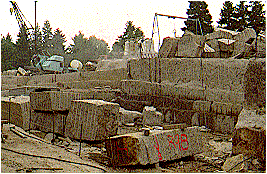DACF Home → Bureaus & Programs → Maine Geological Survey → Explore Maine Geology → Mining and Quarrying in Maine → History of Quarrying
History of Quarrying in Maine
 Maine has a long, interesting history of mining and quarrying activity. Due to the intricacy of its bedrock geology there are many kinds of rock, mineral, and metal deposits in different parts of the state. This variety has allowed continuous mineral production of some sort since the early 1800's even as individual commodities have gone through boom-and-bust cycles. Perhaps the most significant factor to enhance the marketability of mineral resources in the 1800's was the accessibility of major quarries to Maine's vital maritime trade.
Maine has a long, interesting history of mining and quarrying activity. Due to the intricacy of its bedrock geology there are many kinds of rock, mineral, and metal deposits in different parts of the state. This variety has allowed continuous mineral production of some sort since the early 1800's even as individual commodities have gone through boom-and-bust cycles. Perhaps the most significant factor to enhance the marketability of mineral resources in the 1800's was the accessibility of major quarries to Maine's vital maritime trade.
Maine granite comes in many colors and textures, with each quarry yielding its own variety of stone. Activity and competition in the granite industry were highest in the late 1800's, reaching a peak in 1901. Many large public buildings such as libraries, post offices, customs houses, and museums built at that time in the eastern US, including New York City, Washington, DC, and Chicago are made of Maine granite. Although they are almost all inactive, the old quarries still dot the landscape, mainly in the coastal region from Penobscot Bay to Washington County.
The Maine slate industry was also big in its day. From 1880 to 1904 Maine was among the top five slate-producing states in the country, providing slate of excellent quality for roofing tiles and other purposes. Many Maine homes and public buildings dating to that time are still protected by their original slate roofs. The "Central Maine Slate Belt" extends approximately from Waterville to Brownville Junction, with most activity having been in southern Piscataquis County. Flagstones made from rock other than slate have come from various local operations through the years.
Limestone quarrying began in the early 1800's and continues today. Small amounts of impure limestone have been quarried in many parts of the state, but the only place that has produced a significant amount of lime is the Rockland-Thomaston area. The "limestone" there is a metamorphosed coarse-grained marble, some of which is quite pure. The mining of feldspar, used as an ingredient in ceramics, began in Topsham in 1852 and expanded into Androscoggin and Oxford Counties to become a major industry by the early 20th century. It was because of their large feldspar crystals that the pegmatite bodies in this area were quarried, and the rare minerals and gemstones that now draw mineral dealers and collectors to the waste dumps were considered to be by-products. Other industrial minerals such as mica and garnet have been produced in small amounts at various times.
Clay has been mined in Maine for well over a century. Clay deposits are widespread in Maine's coastal counties, particularly in the Presumpscot Formation of Pleistocene age. This formation originated as finely ground "rock flour" produced by glacial abrasion, and has a complex mineral makeup. Therefore, Maine's common clays have a different composition from fire clay of the Mid-Atlantic states that formed by deep chemical weathering. Maine clay cannot compete with fire clay for high-temperature, refractory industrial products. But clay from Maine is quite suitable for common brick made in local brickyards. In the early half of this century many towns had small brickyards. For example, a U.S. Geological Survey report from 1911 describes three brickyards using clay from two pits right in the city of Portland. Brick is still produced in New Goucester and at a few other places in the State. Other products such as concrete, clay tile, and pottery have used Maine clay.
The resource of greatest economic value in recent years is "aggregate," which is unconsolidated material such as sand, gravel, or crushed stone used for paving and construction. Maine's surficial geology includes a large number of sand and gravel deposits, found in most areas of the state, which are utilized for this purpose. Studies by the Maine Geological Survey have shown that Maine's clays can be processed to make good lightweight aggregate for concrete blocks, structural concrete, and pre-cast units. While this application has not yet been developed, the extensive clay deposits in coastal regions offer a vast supply of raw material.
Last updated on October 6, 2005